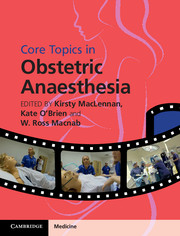Book contents
- Frontmatter
- Contents
- List of contributors
- Preface
- Section 1 Basic science, epidemiology and service organization
- Section 2 Obstetric aspects
- Section 3 Provision of anaesthesia
- Section 4 Medical conditions in pregnancy
- Section 5 Postpartum complications and obstetric emergencies
- 25 Maternal collapse, including massive obstetric haemorrhage, amniotic fluid embolism and cardiac arrest
- 26 Postpartum complications, follow-up and maternal satisfaction
- Section 6 Service organization
- Index
- Plate section
- References
25 - Maternal collapse, including massive obstetric haemorrhage, amniotic fluid embolism and cardiac arrest
from Section 5 - Postpartum complications and obstetric emergencies
Published online by Cambridge University Press: 05 December 2015
- Frontmatter
- Contents
- List of contributors
- Preface
- Section 1 Basic science, epidemiology and service organization
- Section 2 Obstetric aspects
- Section 3 Provision of anaesthesia
- Section 4 Medical conditions in pregnancy
- Section 5 Postpartum complications and obstetric emergencies
- 25 Maternal collapse, including massive obstetric haemorrhage, amniotic fluid embolism and cardiac arrest
- 26 Postpartum complications, follow-up and maternal satisfaction
- Section 6 Service organization
- Index
- Plate section
- References
Summary
Definition
Maternal collapse is defined as an acute event involving the cardiorespiratory systems and/or brain, resulting in a reduced or absent conscious level (and potentially death), at any stage in pregnancy and up to 6 weeks after delivery. Although collapse is often unpredicted, early warning scoring systems can help to identify deterioration and prompt initiation of interventions that can prevent collapse.
Incidence
Accurate figures are not available as this data is not routinely collected, but the incidence of maternal collapse is estimated to lie between 0.14 and 6/1000 pregnancies. As this is not a commonly encountered scenario, it is essential that care-givers are skilled in effective initial resuscitation techniques and investigation and diagnosis of the cause of the collapse, thus enabling appropriate, directed continuing management. Due to lack of robust data, accurate survival rates following maternal collapse are not available, but the ‘near-miss’ to death ratios from two large severe morbidity studies are 56:1 and 79:1.
The team
In addition to the standard members, the arrest team should also include a senior midwife, an obstetrician and an obstetric anaesthetist. This ensures that skilled care-givers (who understand the altered physiology of pregnancy and the impact of this on resuscitation) are able to implement directed, cause-specific treatment and effect delivery if indicated. Units must ensure there is a robust system in place for calling the appropriate team. The consultant obstetrician and consultant obstetric anaesthetist should be alerted and asked to attend. If the collapsed woman is over 22 weeks’ gestation, the neonatal team should be alerted and prepared if perimortem delivery is required. In cases where resuscitation is successful, the critical care team should then be involved in the ongoing management. Communication and clear definition of roles are essential during the resuscitation process.
In general, roles are as follows:
• Anaesthetist to manage the airway and breathing
• Two care-givers to perform chest compressions (rotating every two minutes to avoid fatigue)
• Two care-givers for the arms (one each), to insert a wide-bore cannula in each arm. One care-giver takes the appropriate bloods, labels and sends the samples, and communicates with laboratories.
- Type
- Chapter
- Information
- Core Topics in Obstetric Anaesthesia , pp. 191 - 200Publisher: Cambridge University PressPrint publication year: 2015

